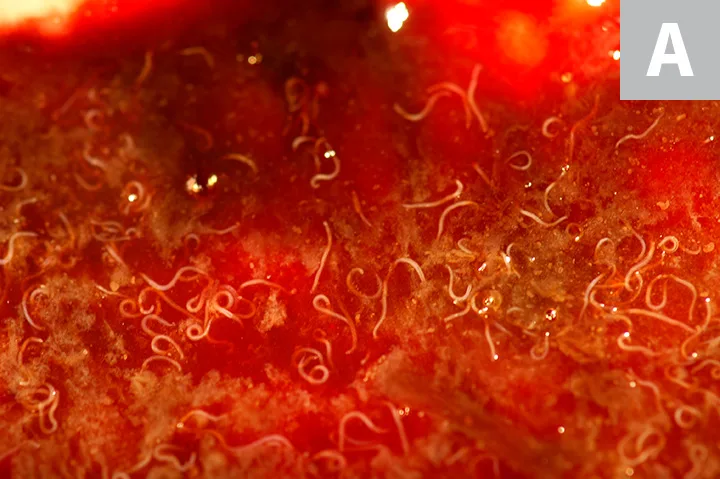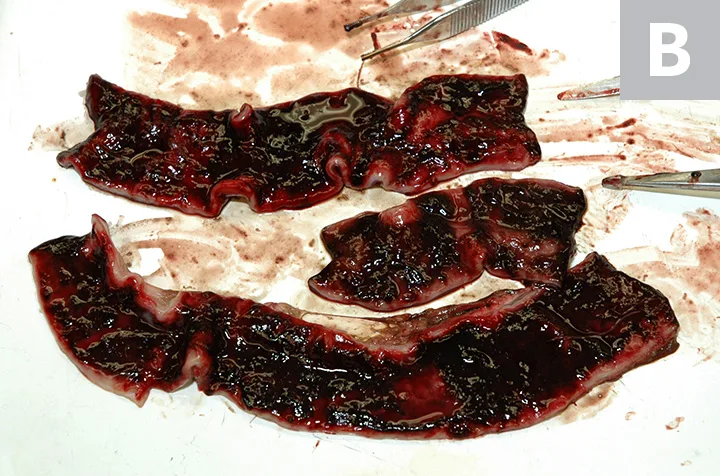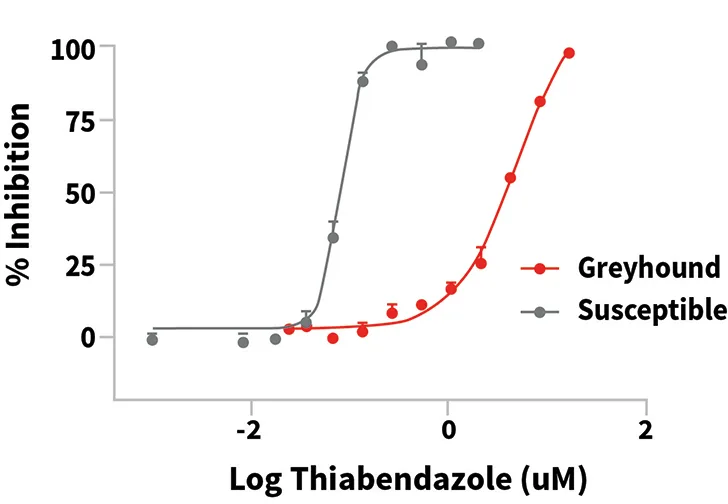NEW RESEARCH: Multiple-Anthelmintic Resistance in the Canine Hookworm
Pablo David Jimenez Castro, DVM, University of Georgia
Ray M. Kaplan, DVM, PhD, DEVPC, DACVM (Parasitology), St. George's University, Grenada, West Indies

The canine hookworm (Ancylostoma caninum) is the most common and highly pathogenic nematode parasite in dogs.1 This parasite uses 3 pairs of teeth to attach to the intestinal mucosa and submucosa to feed on host blood. Clinical signs of infection include hematochezia, melena, anemia, and weight loss; heavy worm burdens can cause death (Figure 1).


Acute lethal hookworm infection showing numerous adults and immature stages of A caninum (A) and enteritis with hemorrhage seen at necropsy (B) in a 3-month-old greyhound that received multiple treatments with fenbendazole, pyrantel pamoate, and ivermectin. Images courtesy of Michael Dryden, DVM, PhD
Research conducted at the Kaplan Laboratory at University of Georgia has led to several key discoveries relating to anthelmintic resistance in A caninum:
1. A CANINUM HAS DEVELOPED MULTIPLE-ANTHELMINTIC RESISTANCE TO ALL COMMONLY USED ANTHELMINTICS.
Research conducted in the authors’ laboratory over the past 2 years has confirmed that A caninum has developed multiple-anthelmintic resistance to the major anthelmintic classes commonly used for treatment: benzimidazoles (eg, fenbendazole, febantel), tetrahydropyrimidines (eg, pyrantel pamoate), and macrocyclic lactones (eg, milbemycin oxime, moxidectin)2; selected data from these studies are presented in Figure 2.
Anthelmintic resistance is defined as a heritable genetic change in a parasite population that enables a significantly greater proportion of individual parasites to survive treatment at a dose that was previously effective against the same species and developmental stage. Strongylid nematode parasites have extremely large effective population sizes that yield exceptionally high levels of genetic diversity that favor the development of anthelmintic resistance.3,4 This has led to long-standing severe resistance problems in GI nematode parasites in livestock; however, few reports have documented such anthelmintic resistance in dogs. The first report of anthelmintic resistance in A caninum was to pyrantel pamoate in 1987 in a greyhound puppy imported from Australia.5 Additional pyrantel pamoate resistance cases were subsequently diagnosed in Australia.6,7 However, since 2008, there had been no further published reports of anthelmintic resistance in A caninum to any drug until 2019.

Dose-response curves for the Egg Hatch Assay, an in vitro assay used to measure resistance to the benzimidazole drug class. The large shift to the right indicates that a much higher concentration of the drug was needed to inhibit egg hatching. In this case, the resistance ratio (ie, ratio of the drug concentration required to inhibit the resistant worms as compared with the susceptible worms) was >60-fold.
2. MULTIPLE-DRUG–RESISTANT HOOKWORMS EVOLVED ON GREYHOUND BREEDING FARMS & RACING KENNELS & HAVE INFECTED MOST ADOPTED GREYHOUNDS.
Evidence recently collected by the Kaplan Laboratory strongly suggests that multiple-drug–resistant (MDR) A caninum evolved on greyhound breeding farms and racing kennels, and most, if not all, actively racing and recently adopted greyhound dogs appear to be infected with these MDR hookworms.
The development of MDR A caninum is most likely the result of a combination of long-term intensive use of anthelmintics and the epidemiologic dynamics that exist on greyhound breeding farms. A caninum is extremely common on greyhound breeding farms, likely due to an ideal environment for larval development and transmission conferred by sand and dirt exercise runs.8 This results in intensive anthelmintic use, which over several decades has likely resulted in heavy selection pressures for drug resistance leading to the development of MDR parasites. The adoption of thousands of retired racing greyhounds each year has likely led to the spread of these MDR parasites to the general pet population. However, to date, there are no data on the prevalence or distribution of MDR hookworms in the pet population. The authors are currently investigating the geographic distribution and the molecular epidemiology of A caninum drug resistance.
3. MDR HOOKWORMS ARE SPREADING TO THE GENERAL DOG POPULATION.
MDR hookworms are not restricted to greyhounds; the authors have observed many cases of drug-resistant hookworms in nongreyhound breeds, suggesting that MDR hookworms are spreading to the general canine population. The emergence and spread of MDR hookworms that are poorly responsive to usual anthelmintic treatments present a serious threat to canine health and necessitate a change in how clinicians manage persistent hookworm cases. In addition, due to its zoonotic potential, the spread of MDR A caninum is also a threat to human health.
4. CLINICIANS SHOULD DETERMINE THE CAUSE OF PERSISTENT A CANINUM INFECTION TO OPTIMALLY MANAGE EACH PATIENT.
Persistent cases of A caninum infection can be caused by either larval leak (ie, arrested larvae in somatic tissues continuously migrate to the small intestine, where they develop to the adult stage9) or true drug resistance; it is important to distinguish between these situations to optimally manage each patient. Dogs with larval leak typically shed hookworm eggs in small numbers, with treatment only yielding a temporary interruption in egg shedding due to newly reactivated larvae repopulating the gut. In contrast, when worms are MDR, treatments fail to interrupt egg shedding. Performing both pretreatment and 14-day post-treatment fecal egg counts is required to make this distinction.
5. ALTHOUGH ALL RESISTANT A CANINUM ISOLATES EXAMINED TO DATE WERE MDR TO ALL 3 DRUG CLASSES, SOME MAY ONLY BE RESISTANT TO 1 OR 2 DRUG CLASSES.
All resistant A caninum isolates that the authors have tested to date have been MDR to all 3 drug classes mentioned previously. However, it is possible that some A caninum isolates are only resistant to 1 or 2 drug classes. Of note, resistance is not an “all or none” phenomenon; resistance levels differ depending on recent treatment history of the dog(s) transmitting and carrying resistant hookworms.
6. ONLY 1 TEST IS CLINICALLY USEFUL FOR DIAGNOSING ANTHELMINTIC RESISTANCE IN A CANINUM.
The only practical method to diagnose anthelmintic resistance in A caninum is the fecal egg count reduction test, in which the number of worm eggs per gram of feces is measured both prior to and 2 weeks after treatment. Most large animal clinicians are familiar with this test, as testing for anthelmintic resistance on livestock farms has long been recommended. Due to the emergence of MDR hookworms in dogs, small animal clinicians should also become familiar with this test, which should be performed in any dog that has persistent hookworms.
Recommendations for performing this test and interpreting the results will be presented by the authors in a diagnostic, treatment, and management algorithm for resistant canine hookworm infections in an upcoming issue of Clinician’s Brief. This algorithm will also provide recommendations for short- and long-term case management.